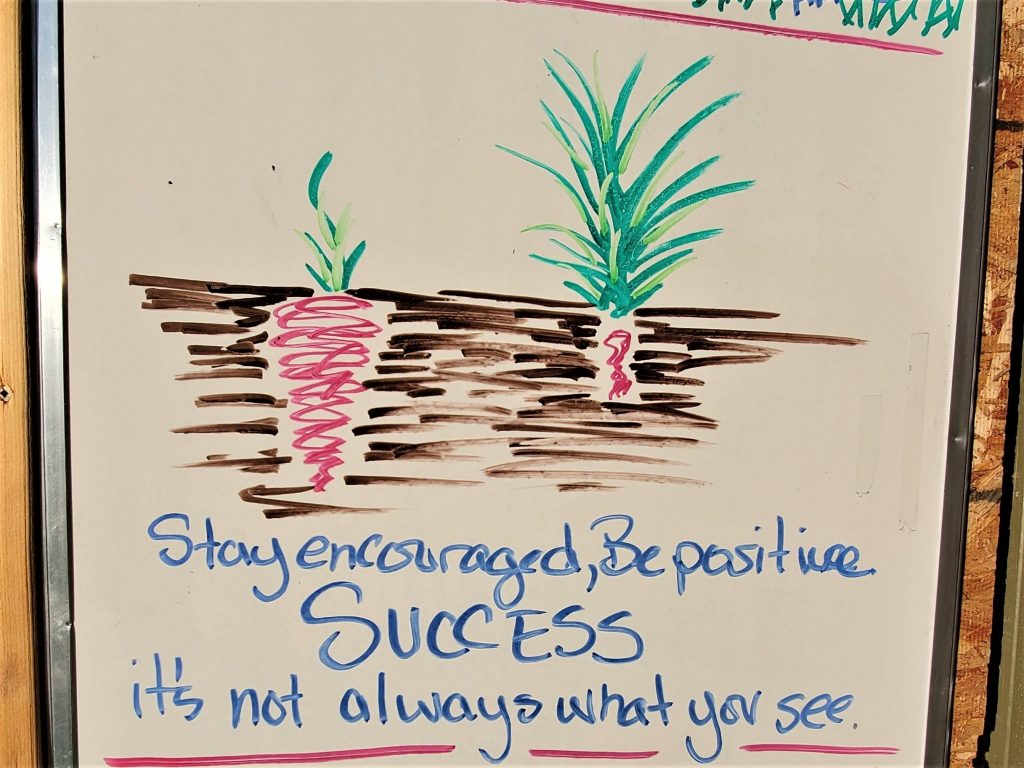I am a member of a local community garden and last week, saw this sign drawn by a gardener on a whiteboard in our garden shed.
Stay encouraged, be positive. SUCCESS – it’s not always what you see.

I immediately thought about the teams and groups that I facilitate and how this garden sign may help them identify their successes and also, the obstacles that may be standing in the way of achieving their goals.
The plant on the left side shows how successes may be flourishing underground; not yet visible and waiting to emerge into the light. The small growth above ground does not show the large vegetable under the soil. In a garden, plants require sun, rain, fertilizer, weeding, staking for support, thinning, and pruning. Similarly, for a team, organization, or group, successes may take time to grow and require attention, support, resources, and modifications. The successes may not be immediately visible; yet may be ready to emerge full-grown.
The plant on the right side depicts the energy going into a large green growth above ground and sadly, a small and withered plant underneath. Perhaps the wrong fertilizer was used, the plant may have been crowded by other plants, or enough water may have not been given. For a team, organization, or group, success may seem to be flourishing yet is short-term and not producing a great result.
Here are two ways to use this garden analogy as an innovative activity in the facilitation of team building, strategic planning, idea generation, conflict reconciliation, or decision-making.
Option 1 Opening Conversation: A 5 to 10-minute individual and pair discussion to generate feelings and ideas
- Show the image. Explain its context as a sign drawn by a community gardener.
- Ask participants to write down or call out their initial feelings and thoughts about how the image depicts successes and challenges experienced by their team, organization, or group. In an online session, they could use the Chat function or a quick Jamboard or part of a Mural or Miro wall. In an in-person session, they can call out or write post-it notes and place them on a wall or floor, or draw.
- In pairs, for 4 minutes, discuss the feelings and ideas that came to mind about the image and their team, organization, or group.
- Invite participants to consider these feelings, thoughts, and ideas as they continue with the topics they are discussing.
Option 2: Team or Group Assessment: A 20 to 30-minute group discussion activity to identify successes and obstacles
- Show the image. Explain its context as a sign drawn by a community gardener.
- Ask participants to write down or call out their first feelings and thoughts about how the image depicts successes and challenges experienced by their team, organization, or group.
- Hand out a worksheet with the image.
- Ask each participant to individually apply the image to their team, organization, work group, etc. by writing on the worksheet their ideas about:
- What is growing in your garden, that is, happening on your team? ( Events, projects, activities, conversations, excitement, tensions, achievements, failures, etc. )
5. Of these items;
- What might be successes that are slowly maturing and not yet visible? (left side plant)
- What might seem to be doing well but may not achieve significant long-lasting results? (right side plant)
- What is happening that you are unsure about in terms of its success or challenge?
6. In groups of three or four, discuss the answers to the questions for about 10 to 15 minutes. Record three main successes as depicted by the left side plant and three main challenges as depicted by the right side plant.
7. In a large group discussion, each small group shares its three main successes and challenges using flipcharts, post-it notes, Mural, Miro, Jamboard, etc.
8. The large group discusses similarities, differences, and ways to apply the ideas as they continue to work as a team or group.
This garden analogy gives your team or group a way to look at its successes and challenges with a different perspective and have fun while doing so. Gardening is about hope. Individuals who work together on a team flourish with hope. Please contact me if you wish to discuss more ways to use the garden activity or other team building and teamwork approaches.
